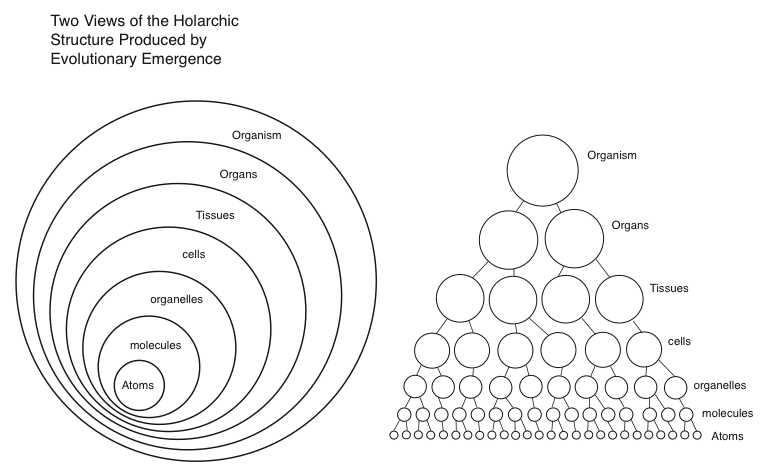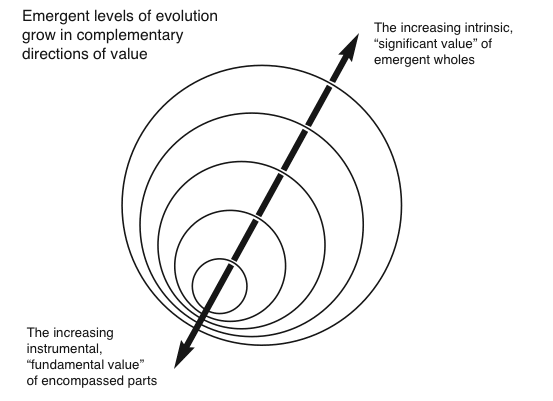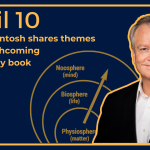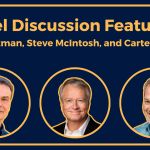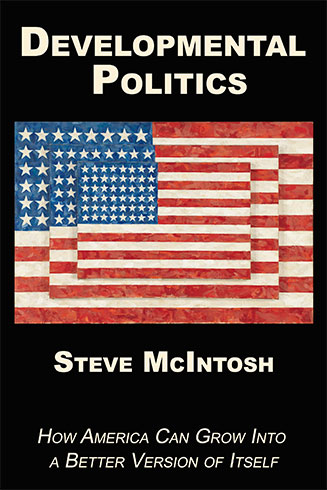Evolution’s Purpose
Chapter Six: Evolutionary Progress in Nature
…/snip/…
The Value of Wholes and Parts
As we are coming to see, one of the primary catalysts that is causing the emergence of this new evolutionary worldview is a deeper understanding of evolution itself. And at the heart of this deeper understanding is a recognition of how the process of evolution generates value naturally and prolifically as it unfolds. To demonstrate this point, in this section we will examine evolution’s trend toward increasing quality using two crucial concepts that are central to integral philosophy. The first concept focuses on the structural pattern produced by evolutionary emergence, and the second concept reveals how this expanding structure of emergence produces complementary forms of intrinsic and instrumental value.
Our analysis begins by reexamining evolution’s natural hierarchy of developmental levels. In chapter 1, we saw how the process of evolution as a whole has manifested itself through three major domains or primary levels of emergence (physical, biological, and cultural), with each domain itself unfolding through a nested sequence of emerging levels. This hierarchical structure is formed by evolution’s basic technique of building increasingly more complex systems upon simpler foundational systems. Although science did not begin to study the processes or structures of emergence until the twentieth century, the deeper meaning of this hierarchical ordering pattern has intrigued philosophers throughout history. Venerable thinkers such as Leibniz and Hegel spent significant time contemplating this structural feature of the natural world.
Then beginning in the 1960s, philosopher Arthur Koestler advanced the theory of “holons” and “holarchy,” which described the pattern created by emergence wherein each evolutionary entity is a whole in one context and a part in another. Koestler pointed out that in the sequence of emergent evolutionary levels, every whole entity is composed of parts, but is also itself “a part” that is included in larger wholes. For example, in the sequence of biological emergence, a cell is simultaneously a whole that contains organelles and molecules, and also a part that is contained by living tissue. Every form of evolutionary organization consists neither of simple wholes nor simple parts; in the organization of evolution there are only “whole/parts,” or what Koestler called “holons.” Moreover, the development of holons does not result in a simple hierarchy, like geological strata stacked on top of each other. Rather, the pattern resembles the structure of an onion or a nested series of concentric spheres that are interdependent and complexly interactive—this structure of evolutionary systems is thus itself a system. Koestler also coined the term “holarchy” to refer to the natural hierarchy formed by evolution’s construction of holons within holons. Figure 6.1 illustrates two complementary views of this developmental pattern: The figure on the left illustrates the nested structure of a holarchy’s “development by envelopment,” as well as how each holarchic level “transcends and includes” its predecessors. The figure on the right illustrates the holarchic principle of “more depth less span.” That is, as emergence builds on itself, higher levels of development are generally less physically numerous than lower levels. This naturally occurring form of organization can be found in practically all forms of evolutionary development.
Figure 6.1. Different graphical representations of the same structure of interdependent hierarchy produced by the emergence of holons, known as a “holarchy”
Koestler’s important insight about the underlying structure of evolution has since been adopted by a number of prominent writers on evolution, including Lynn Margulis and Ken Wilber. Recognizing the evident growth in value demonstrated by this pattern, Wilber writes:
In any developmental or growth sequence, as a more encompassing stage or holon emerges, it includes the capacities and patterns and functions of the previous stage (i.e., of the previous holons), and then adds its own unique (and more encompassing) capacities. In that sense, and that sense only, can the new and more encompassing holon be said to be “higher” or “deeper.” … Organisms include cells, which include molecules, which includeatoms (but not vice a versa). Thus, whatever the important value of the previous stage, the new stage has that enfolded in its own makeup, plus something extra (more integrative capacity, for example), and that “something extra” means “extra value” relative to the previous (and less encompassing) stage. This crucial definition of a “higher stage” was first introduced in the West by Aristotle and in the East by Shankara and Lieh-tzu; it has been central to developmental studies ever since.9
Wilber’s explanation of the growth of value through holarchical development begins to reveal the connection between the theory of holons and the theory of intrinsic and instrumental value introduced above. Recall that intrinsic value is a good in itself, and instrumental value is a good for something other. Applying the recognition of these complementary categories of value to evolution’s whole/part pattern, we find that holons exhibit both kinds of value as a result of their participation within this structural sequence. That is, in their function as parts, holons are instrumentally valuable to the larger wholes that embrace them. And in their role as whole entities, holons possess intrinsic value in themselves. This recognition of the simultaneous existence of both instrumental and intrinsic value within evolutionary forms provides the basis of Holmes Rolston’s influential environmental ethics. Rolston explains:
Organisms value other organisms and earthen resources instrumentally. … Plants make resourceful use of water and sunshine. Insects value the energy that plants have fixed by photosynthesis; warblers value insect protein; falcons value warblers. … Organisms value these resources instrumentally because they value something intrinsically: their selves, their form of life. No warbler eats insects in order to become food for a falcon; the warbler defends her own life as an end in itself and makes more warblers as she can. From the perspective of a warbler, being a warbler is a good thing. … A life is defended intrinsically, without further contributory reference—unless to defend the species and that still is to defend a form of life as an end in itself. Such defenses go on before humans are present; and thus both instrumental and intrinsic values are objectively present in ecosystems. The system is a web where loci of intrinsic value are meshed in a network of instrumental value.10
Rolston’s description of the presence of both intrinsic value and instrumental value within biological systems has been extended by Wilber, who describes how these different forms of value increase in opposing yet complementary directions as evolutionary holarchies build over time. In other words, as evolution unfolds it results in both increasing intrinsic value and increasing instrumental value.
Beginning with intrinsic value, Wilber observes that as evolution produces larger and larger encompassing holonic levels, each new level contains more and more parts, and thus more and more whole entities. And as holons come to embrace more whole/parts within themselves, this increases their intrinsic value, or what he calls their “evolutionary significance.” Wilber thus concludes that “cells are more significant than molecules, because cells contain molecules … An ape is more significant than a cell, and so on.”11
Yet according to this theory of “holonic ecology,” as evolutionary levels grow in wholeness or intrinsic value by embracing more parts, the parts themselves simultaneously become more and more instrumentally valuable. For example, in the scheme of evolution, as atoms are encompassed by molecules, and as molecules are in turn encompassed by cells, and then cells by organs, the underlying atomic level is taken up and used by more and more evolutionary entities. And as a given holonic level becomes increasingly more useful in this way, it becomes more instrumentally valuable to the successively larger wholes that embrace it. As Wilber explains, “the more partness-value a holon has—that is, the greater number of wholes of which that holon is a part—the more fundamental that holon is … An atom is more fundamental than an ape.”12 This conclusion is supported by the fact that atoms can exist without apes, but not vice versa. (Note that Wilber uses the terms “fundamental” and “significant” as synonyms for instrumental and intrinsic value respectively; and we will continue to use these synonyms interchangeably as our discussion continues.) Using the structure of emergence first shown in figure 6.1, figure 6.2 illustrates the key theoretical insight that shows how evolution generates value in opposite yet complementary directions as it unfolds.
Figure 6.2. Directions of growing value in evolution
The philosophical perspective that can recognize growth in both fundamental value and significant value helps us overcome both extremes in our interpretation of progress—the view that flattens all hierarchy and recognizes no progress, as well as the view that values only humans and is blind to the intrinsic value of nature. This philosophy affirms that all life has intrinsic value while also recognizing that some forms of life are more significant than others. And this theoretical approach provides a way to validate our moral intuition that the evolution of life has indeed progressed from its simple beginnings, and that humans are “higher” than other forms of life. What makes humans more evolved is our embodiment of a level of emergence that transcends biology. The physical bodies of humans may not be that different from the bodies of other complex mammals, but our minds, elevated by cultural evolution, constitute a level of emergence that distinguishes us from our animal cousins.
…/snip/…
